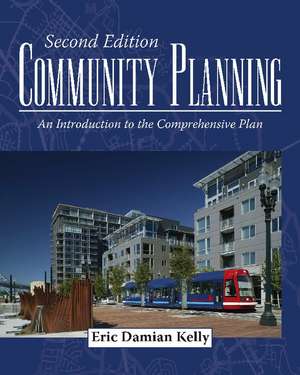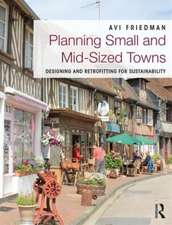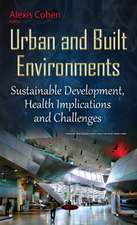Community Planning: An Introduction to the Comprehensive Plan, Second Edition
Autor Eric Damian Kellyen Limba Engleză Paperback – 28 sep 2009
This book introduces community planning as practiced in the United States, focusing on the comprehensive plan. Sometimes known by other names—especially master plan or general plan—the type of plan described here is the predominant form of general governmental planning in the U.S. Although many government agencies make plans for their own programs or facilities, the comprehensive plan is the only planning document that considers multiple programs and that accounts for activities on all land located within the planning area, including both public and private property.
Written by a former president of the American Planning Association, Community Planning is thorough, specific, and timely. It addresses such important contemporary issues as sustainability, walkable communities, the role of urban design in public safety, changes in housing needs for a changing population, and multi-modal transportation planning. Unlike competing books, it addresses all of these topics in the context of the local comprehensive plan.
There is a broad audience for this book: planning students, practicing planners, and individual citizens who want to better understand local planning and land use controls. Boxes at the end of each chapter explain how professional planners and individual citizens, respectively, typically engage the issues addressed in the chapter. For all readers, Community Planning provides a pragmatic view of the comprehensive plan, clearly explained by a respected authority.
Written by a former president of the American Planning Association, Community Planning is thorough, specific, and timely. It addresses such important contemporary issues as sustainability, walkable communities, the role of urban design in public safety, changes in housing needs for a changing population, and multi-modal transportation planning. Unlike competing books, it addresses all of these topics in the context of the local comprehensive plan.
There is a broad audience for this book: planning students, practicing planners, and individual citizens who want to better understand local planning and land use controls. Boxes at the end of each chapter explain how professional planners and individual citizens, respectively, typically engage the issues addressed in the chapter. For all readers, Community Planning provides a pragmatic view of the comprehensive plan, clearly explained by a respected authority.
Preț: 398.43 lei
Nou
Puncte Express: 598
Preț estimativ în valută:
76.24€ • 79.80$ • 63.46£
76.24€ • 79.80$ • 63.46£
Carte disponibilă
Livrare economică 10-24 martie
Livrare express 22-28 februarie pentru 54.28 lei
Preluare comenzi: 021 569.72.76
Specificații
ISBN-13: 9781597265539
ISBN-10: 1597265535
Pagini: 424
Ilustrații: 37 photos, 58 illustrations
Dimensiuni: 203 x 267 x 23 mm
Greutate: 0.89 kg
Ediția:Second Edition, Second Edition, Second Edition
Editura: Island Press
Colecția Island Press
ISBN-10: 1597265535
Pagini: 424
Ilustrații: 37 photos, 58 illustrations
Dimensiuni: 203 x 267 x 23 mm
Greutate: 0.89 kg
Ediția:Second Edition, Second Edition, Second Edition
Editura: Island Press
Colecția Island Press
Notă biografică
Eric Kelly is a professor of urban planning at Ball State University. He is a past president of the American Planning Association and has more than thirty years of experience consulting with local governments in thirty-five states.
Cuprins
Introduction
Updates to the Second Edition
Substance and Structure of the Book
Focus on Comprehensive Planning
Legal and Historical Significance
Relationship to Other Kinds of Planning
A Pragmatic Note
The Role of Planners
The Role of Individual Citizens
Users' Guide
Glossary of Key Terms
PART I. The Comprehensive Planning Process
Chapter 1. Some Overarching Issues: Sustainability, Sprawl, and Human Health
-Relationship to Climate Change
-Complexity of the Issues
-Sprawl
-Resources and Sustainability
-Human Health
-School Facility Siting
-Conclusion
Chapter 2. Introduction to Planning
-Elements of a Planning Process
-Community Planning in Concept
-Systems Thinking and Planning
-Planning Traditions in the United States
-Planning in a Contemporary Democracy
-Maps as Planning Tools
-The Role of GISs
-Conclusion
Chapter 3. Introduction to the Comprehensive Plan
-Comprehensive Plan Defined: Examples
-Historical Evolution of the Comprehensive Plan
-Elements of a Comprehensive Plan
-The Planning Commission
-Updating the Plan
-Conclusion
Chapter 4. Analysis of Existing Conditions in the Community
-Practical Aspects of Existing Condition Analysis
-Conclusion
Chapter 5. Projecting Possible Futures for the Community
-Techniques for Determining What Is Feasible
-Bringing Feasibility into the Planning Process
-Conclusion
Chapter 6. Involving Citizens in Making a Plan
-Methods of Achieving Citizen Participation
-Different Approaches to Planning and Citizen Participation
-Techniques for Citizen Participation
-Conclusion
PART II. The Plan as a Document
Chapter 7. Planning for Future Land Use
-Creating the Future Land Use Map
-Basic Principles
-Mapping Uses
-Conclusion
Chapter 8. Planning for Public Facilities Such as Parks, Roads, and Utilities
-Overview of the Issues
-Federal, State, and Regional Involvement
-Planning for Roads and Other Infrastructure
-Planning for Multiple Modes of Transportation
-Planning for or around Other Transportation Facilities
-Planning for Sewer and Water Systems
-Planning for Other Utilities
-Planning for Parks, Open Space, and Green Infrastructure
-Planning for Schools, Fire Stations, and Other Facilities
-Planning for Telecommunication Infrastructure
-Technology and the Landscape
-Conclusion
Chapter 9. Putting It All Together
-The Adoption Process
-The Final Plan
-The Best Format for an Adopted Plan
-What Does the Official Plan Include?
-Is the Final Plan Internally Consistent?
-Conclusion
PART III. Making Plans Work
Chapter 10. Decisions That Change the Land
-How Development Occurs
-How Planning Can Distort the Market
-Where the Market Partly Follows the Plan
-Conclusion
Chapter 11. Controlling the Use of Private Land through Zoning
-Regulating Use
-Cumulative and Noncumulative Zoning
-Regulating Intensity
-Regulating Dimensions
-Design Implications of Traditional Zoning
-Variances
-Uses by Review
-Contemporary Zoning Reforms
-The Zoning Map
-Conclusion
Chapter 12. Controlling the Development of Land
-Concept and Substance of Subdivision Regulation
-Street Layout and Connectivity
-Planning for Pedestrian and Bicycle Circulation
-Private Streets
-Planning for Stormwater
-Open Space and Green Infrastructure
-Other Public Facilities Required in Subdivisions
-Subdivision Review Process
-Paying for Public Improvements
-Exactions
-Site Planning
-Conclusion
Chapter 13. Controlling When and Where Development Takes Place
-Growth Management Programs
-APF Controls
-Phased-Growth Programs
-Rate-of-Growth Programs
-Urban Growth and Urban Service Area Boundaries
-Annexation
-Smart Growth
-Conclusion
Chapter 14. Deciding When and Where to Build New Public Facilities
-Policy and Political Issues
-Link between CIP and Planning
-Sustainability, or Shaping Growth to Fit the Plan
-Adoption of CIPs
-Conclusion
Chapter 15. Fitting the Plans Together: The Regional Perspective
-The Government Context
-The Challenge and the Opportunity
-Regional Planning in the United States
-Municipal Planning and Zoning beyond Municipal Boundaries
-Other Legislative Models
-A Note on Larger Regions: Megapolitans and Others
-Conclusion
Chapter 16. Planning for Parks, Open Space, and Green Infrastructure
-Classification of Open Lands
-Agricultural Land
-The Value of Open Space
-Planning for All Open Space Needs
-Ownership and Acquisition of Open Space
-Conclusion
PART IV. Plans for Special Topics or Areas
Chapter 17. Planning for Particular Geographic Areas
-Neighborhood Plans
-District or Sector Plans
-Downtown Plans
-Historic District Plans
-Plans for Agricultural and Sensitive Environmental Areas
-Plans for Other Types of Districts
-Plans for Major Road Corridors and Gateways
-The Planning Process for Specific Areas
-Conclusion
Chapter 18. Planning for Renewal and Revitalization
-The Need for Renewal
-Large-Scale Renewal Efforts
-Public–Private Partnerships
-Common Areas Targeted for Revitalization
-Issues
-Conclusion
Chapter 19. Planning for Natural Hazards and Community Safety
-Creating Safer Public Places
-Designing Streets to Facilitate Emergency Response
-Addressing Risks from Nature
-Conclusion
Chapter 20. Planning for Housing
-Housing Supply and Demand
-The Fair Housing Act and Americans with Disabilities Act
-Effect of Financing, Tax, and Highway Policies
-The Role of Local Government
-Local and State Affordable Housing Programs
-Conclusion
Chapter 21. Planning for Jobs
-Principles of Economic Development
-The Context for Economic Development
-An Economic Development Plan
-Opportunities in Small Business
-Implementation Strategies
-Economic Development and Comprehensive Planning
-Sustainable Economic Development
-Conclusion
PART V. The Planning Profession
Chapter 22. Planning Ethics and Values
-Values
-Ethics
-Applying These Principles
-Other Ethical Principles
-Conclusion
Chapter 23. Becoming a Planner or Planning Commission Member
-What Makes a Good Planner
-Serving on a Planning Commission
-Conclusion
Acknowledgments
Notes
Bibliography
Index
Updates to the Second Edition
Substance and Structure of the Book
Focus on Comprehensive Planning
Legal and Historical Significance
Relationship to Other Kinds of Planning
A Pragmatic Note
The Role of Planners
The Role of Individual Citizens
Users' Guide
Glossary of Key Terms
PART I. The Comprehensive Planning Process
Chapter 1. Some Overarching Issues: Sustainability, Sprawl, and Human Health
-Relationship to Climate Change
-Complexity of the Issues
-Sprawl
-Resources and Sustainability
-Human Health
-School Facility Siting
-Conclusion
Chapter 2. Introduction to Planning
-Elements of a Planning Process
-Community Planning in Concept
-Systems Thinking and Planning
-Planning Traditions in the United States
-Planning in a Contemporary Democracy
-Maps as Planning Tools
-The Role of GISs
-Conclusion
Chapter 3. Introduction to the Comprehensive Plan
-Comprehensive Plan Defined: Examples
-Historical Evolution of the Comprehensive Plan
-Elements of a Comprehensive Plan
-The Planning Commission
-Updating the Plan
-Conclusion
Chapter 4. Analysis of Existing Conditions in the Community
-Practical Aspects of Existing Condition Analysis
-Conclusion
Chapter 5. Projecting Possible Futures for the Community
-Techniques for Determining What Is Feasible
-Bringing Feasibility into the Planning Process
-Conclusion
Chapter 6. Involving Citizens in Making a Plan
-Methods of Achieving Citizen Participation
-Different Approaches to Planning and Citizen Participation
-Techniques for Citizen Participation
-Conclusion
PART II. The Plan as a Document
Chapter 7. Planning for Future Land Use
-Creating the Future Land Use Map
-Basic Principles
-Mapping Uses
-Conclusion
Chapter 8. Planning for Public Facilities Such as Parks, Roads, and Utilities
-Overview of the Issues
-Federal, State, and Regional Involvement
-Planning for Roads and Other Infrastructure
-Planning for Multiple Modes of Transportation
-Planning for or around Other Transportation Facilities
-Planning for Sewer and Water Systems
-Planning for Other Utilities
-Planning for Parks, Open Space, and Green Infrastructure
-Planning for Schools, Fire Stations, and Other Facilities
-Planning for Telecommunication Infrastructure
-Technology and the Landscape
-Conclusion
Chapter 9. Putting It All Together
-The Adoption Process
-The Final Plan
-The Best Format for an Adopted Plan
-What Does the Official Plan Include?
-Is the Final Plan Internally Consistent?
-Conclusion
PART III. Making Plans Work
Chapter 10. Decisions That Change the Land
-How Development Occurs
-How Planning Can Distort the Market
-Where the Market Partly Follows the Plan
-Conclusion
Chapter 11. Controlling the Use of Private Land through Zoning
-Regulating Use
-Cumulative and Noncumulative Zoning
-Regulating Intensity
-Regulating Dimensions
-Design Implications of Traditional Zoning
-Variances
-Uses by Review
-Contemporary Zoning Reforms
-The Zoning Map
-Conclusion
Chapter 12. Controlling the Development of Land
-Concept and Substance of Subdivision Regulation
-Street Layout and Connectivity
-Planning for Pedestrian and Bicycle Circulation
-Private Streets
-Planning for Stormwater
-Open Space and Green Infrastructure
-Other Public Facilities Required in Subdivisions
-Subdivision Review Process
-Paying for Public Improvements
-Exactions
-Site Planning
-Conclusion
Chapter 13. Controlling When and Where Development Takes Place
-Growth Management Programs
-APF Controls
-Phased-Growth Programs
-Rate-of-Growth Programs
-Urban Growth and Urban Service Area Boundaries
-Annexation
-Smart Growth
-Conclusion
Chapter 14. Deciding When and Where to Build New Public Facilities
-Policy and Political Issues
-Link between CIP and Planning
-Sustainability, or Shaping Growth to Fit the Plan
-Adoption of CIPs
-Conclusion
Chapter 15. Fitting the Plans Together: The Regional Perspective
-The Government Context
-The Challenge and the Opportunity
-Regional Planning in the United States
-Municipal Planning and Zoning beyond Municipal Boundaries
-Other Legislative Models
-A Note on Larger Regions: Megapolitans and Others
-Conclusion
Chapter 16. Planning for Parks, Open Space, and Green Infrastructure
-Classification of Open Lands
-Agricultural Land
-The Value of Open Space
-Planning for All Open Space Needs
-Ownership and Acquisition of Open Space
-Conclusion
PART IV. Plans for Special Topics or Areas
Chapter 17. Planning for Particular Geographic Areas
-Neighborhood Plans
-District or Sector Plans
-Downtown Plans
-Historic District Plans
-Plans for Agricultural and Sensitive Environmental Areas
-Plans for Other Types of Districts
-Plans for Major Road Corridors and Gateways
-The Planning Process for Specific Areas
-Conclusion
Chapter 18. Planning for Renewal and Revitalization
-The Need for Renewal
-Large-Scale Renewal Efforts
-Public–Private Partnerships
-Common Areas Targeted for Revitalization
-Issues
-Conclusion
Chapter 19. Planning for Natural Hazards and Community Safety
-Creating Safer Public Places
-Designing Streets to Facilitate Emergency Response
-Addressing Risks from Nature
-Conclusion
Chapter 20. Planning for Housing
-Housing Supply and Demand
-The Fair Housing Act and Americans with Disabilities Act
-Effect of Financing, Tax, and Highway Policies
-The Role of Local Government
-Local and State Affordable Housing Programs
-Conclusion
Chapter 21. Planning for Jobs
-Principles of Economic Development
-The Context for Economic Development
-An Economic Development Plan
-Opportunities in Small Business
-Implementation Strategies
-Economic Development and Comprehensive Planning
-Sustainable Economic Development
-Conclusion
PART V. The Planning Profession
Chapter 22. Planning Ethics and Values
-Values
-Ethics
-Applying These Principles
-Other Ethical Principles
-Conclusion
Chapter 23. Becoming a Planner or Planning Commission Member
-What Makes a Good Planner
-Serving on a Planning Commission
-Conclusion
Acknowledgments
Notes
Bibliography
Index
Recenzii
"Eric Damian Kelly's Community Planning, Second Edition is nothing less than a master work planning practice. Whether you are a student or seasoned pro, you absolutely cannot be withou it. Kelly goes well beyond the conventional land use perspective in describing the formulation of comprehensive plans and addressing all plan elements and how they fit together. Moreover, he teases out implementation issues in evey chapter, propelling the reader from analysis to action. Finally there is always an ethical backdrop in this book, distinguishing it from others in the field. Kelly reminds us that we are commanded to 'replenish the earth' as a basic concept in sustainability—wise advice, like everything in this magnificent text."
Descriere
This book introduces community planning as practiced in the United States, focusing on the comprehensive plan. Sometimes known by other names—especially master plan or general plan—the type of plan described here is the predominant form of general governmental planning in the United States. Although many government agencies make plans for their own programs or facilities, the comprehensive plan is the only planning document that considers multiple programs and that accounts for activities on all land located within the planning area, including both public and private property.
Written by a former president of the American Planning Association, Community Planning is thorough, specific, and timely. For all readers, including professional planners, planning students, and interested citizens, it provides a valuable and pragmatic view of the comprehensive plan.













